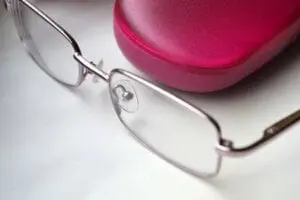Anyone who has ever worn glasses understands how uncomfortable a pair can be if they are not properly fitted and adjusted. While industry pros are capable of only slightly adjusting plastic frames, there are a variety of ways that metal frames can be adjusted for an ideal fit. Experts know that the one of the most common ways of adjusting metal frames is through the nose pads.
Read on for a quick guide to some of the most popular types of nose pads used on metal frame glasses, and how an Optician can select the right ones for their client.

Understanding Nose Pad Materials as a Dispensing Optician
While optical nose pads are available in a wide range of materials, professionals know that there are two types that are most common: plastic and silicone. Graduates of optician programs know that silicone is generally the most comfortable material for nose pads. It is soft and flexible, and moulds to the contours of the wearer’s nose.
However, silicone nose pads are not perfect, as their porous material easily absorbs sweat and dirt. Causing a slight discoloration to occur about every six months. Once you have earned your optician diploma, it is important to have your clients check in with you at least twice a year to have their silicone pads switched out for new ones.
Plastic nose pads, on the other hand, have a much more rigid feel compared to silicone ones. Opticians know that nose pads made from this material tend to be much less comfortable than the silicone pads, and do not contour to the face the same way.
Opticians Choose the Best Method to Mount Nose Pads
Students enrolled in Licensed Optician courses will learn that there are several ways that nose pads can be mounted onto a pair of metal frame glasses.
Dispensing Opticians always have screw on nose pads on hand, since these are the most popular type. They are held onto the frames by a tiny screw that slides through a hole beneath the nose pad and the frame’s guard arm. If a customer should need replacement screw on pads, it is important to recommend that they see a certified optician. A screwdriver must be used and it can easily slip and scratch the lenses.
Snap on nose pads are also quite common. They come in a variety of materials and are very easy to replace. They can be found at virtually any eyeglasses store and they simply click on and off of the frames.
Professional Opticians Understand the Importance of Nose Pad Shape and Size
Professional Licensed Opticians know that nose pads are made in sizes. Ranging from approximately 9mm to 24mm, and they come in many different shapes. It is important that an Optician select the right size for his or her client, depending on their specific features. Symmetrical nose pads are all identical and can be used on both the left side and the right. These are ideal for opticians as the guesswork usually involved in differentiating the left from the right pad is eliminated. Asymmetrical nose pads consist of a pad designated to wither the right or left side of a frame. Experts know that the flat edge of these pads should always face away from the face.
Would you like to learn more about optical retail? Find out more about Stenberg College’s Optician Diploma Program!










